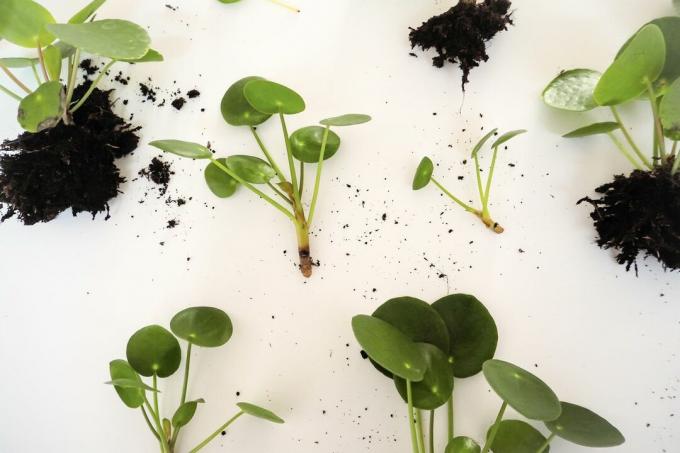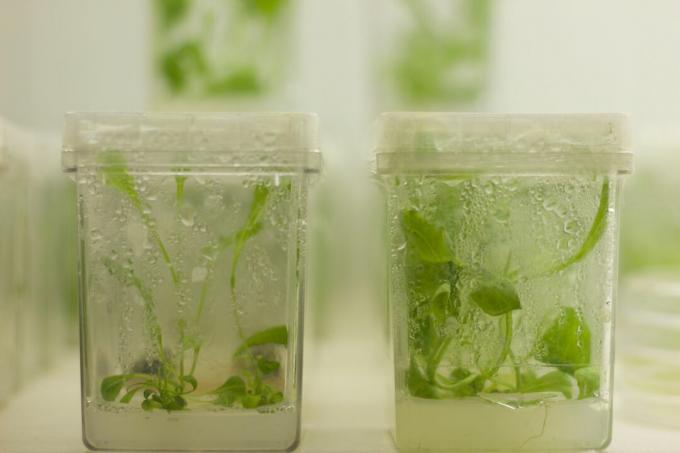The production of clones is part of everyday life in the plant world. So-called vegetative propagation can also make life easier for the hobby gardener.

Vegetative reproduction is also known as "asexual" or "asexual" reproduction. Plant life reproduces without the seeds produced as a result of fertilization. In the usual reproduction of flowering plants via seeds - also as generative, refers to sexual or sexual reproduction - a male pollen meets a female egg cell. If these two components are compatible with each other, fertilization can occur and a plant may grow from the resulting seed. With vegetative propagation, on the other hand, a new plant is created exclusively from dividing cells of the mother plant: without any flowering, fertilization or formation of a seed. Consequently, the genetic material of the offspring is identical to that of the mother plant. Clones are created by vegetative propagation. What is classified as an absolute taboo for animal organisms is even practiced by plants in nature. Certain species have developed specific mechanisms with which they can reproduce vegetatively and no longer have to ensure their offspring by producing seeds.
contents
- Vegetative propagation in plants
-
Vegetative propagation: examples
- Offshoots and sinkers
- moss
- foothills/kindel
- tubers and onions
- In vitro propagation
- rhizome division
- cuttings
- finishing
- Vegetative Reproduction - Plants program themselves
- Basis for regrowing vegetables
Vegetative propagation in plants
For the gardener, this is of great benefit in many ways. With the help of vegetative forms of propagation, he or she can specifically clone and reproduce a plant with special properties. It also usually takes much less time for vegetatively propagated plants to flower or bear fruit, for example, than plants propagated from seeds. And if certain plants do not produce seeds or if they germinate very slowly, vegetative propagation offers a quick and easy way to circumvent this problem.

But in horticultural production, this form of propagation is usually only used if it absolutely does not work through sexual propagation by sowing. The asexual propagation of plants usually means significantly higher costs for the gardener than if the plant is propagated by seeds.
Vegetative propagation: examples
There are many different forms of vegetative propagation. Not every plant can be propagated vegetatively in every way. And not all forms occur in nature, because sometimes humans take advantage of plants' abilities and force them to clone themselves. Therefore follows a brief overview of examples of vegetative propagation and when the different forms occur:
offshootandlowering
Here, individual shoots are tied down towards the ground and either completely sunk into the ground (offshoot) or only brought into contact with the ground at one point, so that the tip of the shoot protrudes upright from the ground (sinker). Roots form at the point of the shoot that is in contact with the ground. In the case of the sinker, this leads to an independent plant. Offshoots sprout first, shoots shoot out of the ground and several independent plants can arise from a discarded shoot.
example: hazelnuts, Haworthia

moss
A shoot of a plant is deliberately injured. At the appropriate place, moist moss is wrapped in cling film. Roots form on the injured area and after a while the shoot can be separated below the newly formed roots. The shoot is now able to feed itself and live as an independent plant.
example: As an alternative to propagation by cuttings when the shoots are too lignified.
foothills/kindel
Runners are also called stolons. Side shoots develop from the mother plant. These end in an independent plant that also puts down roots. The side rungs can run above or below ground.
example: Strawberry (above ground)

tubers and onions
Tubers are thickened plant organs like roots or underground shoots. On the one hand, they serve to store important substances and, on the other hand, a plant can develop from each individual tuber. The same applies to onions. Botanically, this is a stunted shoot with thickened, low leaves. Most bulbous plants form so-called daughter bulbs all by themselves, which can grow into independent plants.
example: potato (tuber), onion (onion)

in vitropropagation
The so-called in-vitro propagation is often used in biotechnology in specialized companies. Plants are grown from young, particularly dividing cells or other tissues. "In vitro" means "in the glass" and describes the process of growing the plants from the small parts of the plant. These are grown on specific substrates containing any materials for development in an air-conditioned room with well-defined conditions. Although this method is extremely promising, it is unfortunately far too complex for the hobby gardener.
If the exact conditions that a species requires in in vitro culture are known, any species can be propagated using this method.

rhizome division
Some plants form so-called rhizomes. These are subterranean shoots. The rhizomes with roots are often used. Since the underground shoots also have buds from which shoots can develop, it is possible to divide the rhizome of a plant and to create several new but identical plants from it.
example: Raspberries
cuttings
Individual leaves, tips of shoots or parts of the shoot axis can be removed from a plant. Planted in substrate, some independent plants then develop from these cuttings. Again, not every cutting method works for every plant. Cuttings are the most important vegetative form of propagation: If a mother plant is available, it can often be propagated easily, relatively quickly and with great success by cuttings.
examples: various herbs
finishing
The so-called refinement is also a way of asexual reproduction. Finishing, in turn, is itself divided into different forms. In general, a part of a coveted plant that is not easy to obtain through other types of propagation is grafted onto a so-called rootstock. Rootstocks are usually easy to raise from seeds or to propagate with cuttings. Another advantage of the rootstocks can be certain growth characteristics or disease resistance, which the desired variety to be grafted cannot show. The plant parts that are grafted onto the rootstock are, for example, shoot sections (grafting) or just individual buds that are planted in the bark of the rootstock (oculation).
examples: fruit trees, cucumbers, tomatoes

There are other forms of vegetative propagation that can be done depending on the plant species. However, the most important thing for gardening in your own garden is without a doubt Propagation via cuttings. Now let's take a closer look at this asexual reproduction.
Vegetative Reproduction - Plants program themselves
The fact that new, independent plants can simply grow from cut plant parts is a great peculiarity in nature. It is possible because plants are able to reprogram cells, so to speak. No matter what function it previously had, whether the cell belonged to leaf, shoot or root, it can forget its function and become part of a new, completely different tissue.
When propagating cuttings, this can be seen from the fact that new roots suddenly appear from the scion grow, although there are no cells present that even come close to anything with roots do have. This phenomenon is also known as the "totipotency" of living plant cells. The younger the cells are, the better this reprogramming of plant cells usually works.
Basis for regrowing vegetables
The vegetative propagation is thus also the basis of the Regrowens - i.e. regrowing - of vegetable leftovers. For example, a clove can be easily removed from the garlic and pressed into the ground. Over time, a new garlic bulb will grow. But with a little skill, the herbs from the windowsill in the kitchen can also be reproduced yourself and the spicy supply can be ensured.

The perfect regrowth of vegetable residues is achieved when the cut upper parts of the plant from pineapple or Kohlrabi be recycled. These parts of the shoot can also simply be stuck in the substrate instead of migrating into the organic waste bin. If this is kept well and evenly moist, after a while roots form from the cut surface in the substrate and a new plant grows up. The same goes with salads. If the lower part of the head of lettuce, which is not really edible, is placed in a well-moist substrate, another head of lettuce will develop from it.

Basically, however, it is important to ensure that the material for vegetative propagation is not left lying in the corner for too long. The longer the storage, the more energy is dissipated and is no longer available for the development of a new daughter plant. At some point, the tissue is no longer vital enough to regenerate and lead to successful asexual reproduction.
Curious? Then try it yourself! These 10 Plants can easily be propagated by cuttings.



